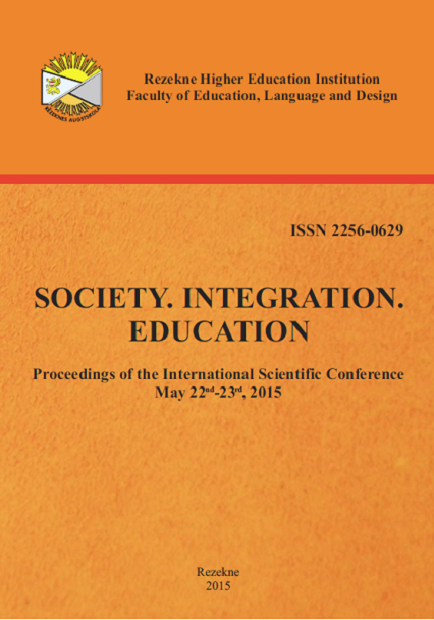Correspondence of the Questionnaire to the Needs of Parents During Hospitalization of Child. Expert evaluation
DOI:
https://doi.org/10.17770/sie2015vol3.481Keywords:
activity research, expert evaluation, strategy of triangulationAbstract
Needs of parents during hospitalization of a child, during the health care process, are connected with the interaction of multilevel environment in the hospital setting. Created expert evaluation questionnaire and performed research serve as a basis for creation of the activity research questionnaire for parents of children and nurses employed in the health care field using acquired data. To heighten validity of the obtained data during each cycle of data analysis triangulated data acquisition methods were used. During research of the needs of parents during hospitalization of their child following methods of triangulation were used: data triangulation – quantitative and qualitative data obtained during research; sources: child’s parents and nurses; triangulation of researchers – author of the dissertation, scientific head of the dissertation, experts; triangulation of theories – sustainability/sustainable development, ecology of human development, holistic health care model, system model; triangulation of methods – questionnaires, expert evaluations, analysis of qualitative data and thematic qualitative analysis. During research the strategy of triangulation contains use of several sources of information. Relatively autonomous research methods give purposeful answers to the research questions on needs of parents during hospitalization of a child. Data obtained during activity research indicate ability of the parents and health care teams to satisfy their needs.
Downloads
References
Avis M., Reardon R. (2008). Understanding the views of parents of children with special needs about the nursing care their child receives when in hospital: a qualitative study. Journal of Child Health Care, Vol 12(1) pp. 7–17.
Bronfenbrenner, U. (2005). (Ed.) Making human beings human: Bioecological perspectives on human development. CA: Sage Publications: Thousand Oaks, pp. 3-15.
Bronfenbrenner, U. (1979). The ecology of human development. Experiments by nature and design. Cambridge, MA Harvard University Press.
Denzin, N. K. (2006). Sociological methods: A Sourcebook by Norman K. Denzin. New Brunswick, N.J.: Aldine Transaction.
Denzin, N. K. (1978). Sociological methods. NewYork: McGraw-Hill.
Junk, J. (2011). Method parallelization and method triangulation: Method combinations in the analysis of humanitarian interventions. German Policy Studies, Vol.7 (3), pp. 83-116.
Izglītība pārmaiņām: ilgtspējīgas attīstības mācīšanas un mācīšanās rokasgrāmata (2008). Pieejams: http://www.balticuniv.uu.se/teacher/index.php?option=com_docman&task=doc _download&gid=469&Itemi (skatīts 2015.gada 7. janvārī).
Learning: The Treasure Within. UNESCO report for Education for the 21st century, published by the German UNESCO Commission. Neuwied; Kriftel; Berlin: Luchterhand, 1997, S. 83.
Ma, A., Norwich, B. (2007). Triangulation and theoretical understanding. International Journal of Social Research Methodology, Vol.10 (3), pp. 211-226.
Macdonald, M.E., Liben S., Carnevale F.A. (2012). An office or a bedroom? Challenges for family-centered care in the pediatric intensive care unit. Journal of Child Health Care, Vol 16(3) pp. 237–249.
Moghaddam, K.B., Moghaddam M.B., Sadeghmoghaddam L., Ahmadi F. (2011). The concept of hospitalization of children from the view point of parents and children. Iran J Pediatr, Vol 21 (2), pp: 201-208.
Neuman, B. (1982). The Neuman health-care systems model: A total approach to client care. In B. Neuman (Ed.), The Neuman systems model: Application to nursing education and practice. Norwalk, CT: Appleton-Century-Crofts,pp. 8-29.
Oleinik, A. (2011). Mixing quantitative and qualitative contentanalysis: Triangulation at work. Quality&Quantity, Vol.45 (4), pp. 859-873.
Patton, MQ. (2001). Qualitative evaluation and research methods (2nd Edition). Thousandoaks’, CA: Sage Publications.
Patton, MQ. (1999) Enhancing the quality and credibility of qualitative analysis. HSR: Health Services Research,Vol. 34 (5), Part II, pp. 1189-1208.
Römpczyk, E. (2007). Gribam ilgtspējīgu attīstību. Rīga: Friedrich-Ebert-Stiftung, 152. lpp. Pieejams: http://www.varam.gov.lv/files/text/Darb_jomas//Book_gribamia.pdf (skatīts 2015. gada 16. janvārī)
Thurmond, V. (2001). The point of triangulation. Journal of Nursing Scholarship, Vol. 33 (3), pp. 253-258.
Tondi M.H. (2010). Family-centered pediatric Nnursing care: State of the science. Journal of Pediatric Nursing Vol. 25, pp. 335–343.
Van Drie, J., Dekker, R. (2013). Theoretical triangulation as an approach for revealing the complexity of a classroom discussion. British Educational Research Journal, Vol.39 (2), pp. 338-360.


